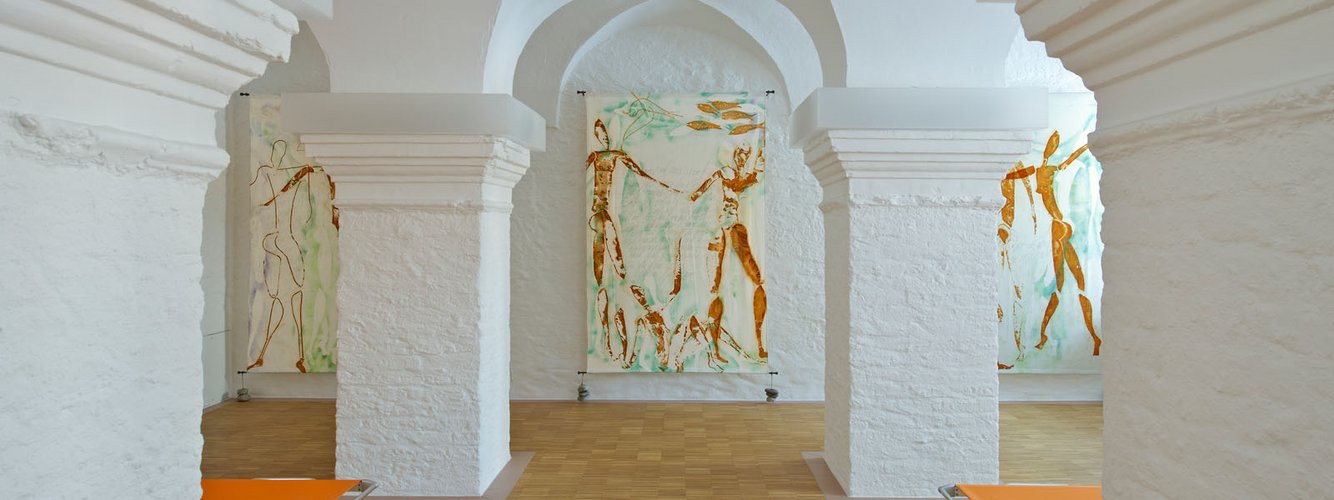

As an institution of the district of Swabia, one of our most important tasks is to create balance between ecological interests and economic, cultural and social objectives. Therefore, we do several things in order to give the interests of accessibility, environmental protection and sustainability the priority they are due. In the following, we will give you an insight into our activities aimed at breaking down disruptive barriers and using natural resources in a responsible manner.
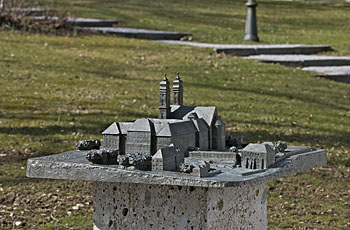
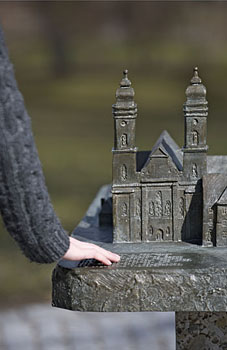
In 2009, the planning began to redesign as many of the areas of the listed ensemble of Irsee Monastery as possible in the barrier-free standard. Since then, two disabled car parks have been set up, four guest rooms have been redesigned as barrier-free and the accessibility of numerous conference rooms, as well as the car park, has been made stepless.
For its 30th anniversary, the centre received a blind touch model created by sculptor Egbert Broerken, which makes the entire Irsee Monastery complex accessible to visually impaired people as well. In June 2012, the conference centre was distinguished as a “barrier-free hotel and catering business” by the Bavarian Ministry of Social Affairs.
In 2014/15, the second structure of Irsee Monastery, the so-called “artist’s workshop building”, was successfully made barrier-free and accessible. Since then, the stepless path to the building, a lift installation in front of the staircase and the installation of a disabled-friendly toilet facility have allowed our guests to use the artist’s workshop room on the top floor and the work rooms on the basement floor of the so-called “A building” in a barrier-free manner.
In 2019, the property received the signet "Bayern barrierefrei". For us, this is as well a symbol of appreciation and as an inducement to pursue even more in accessibility. Please see www.barrierefrei.bayern.de .
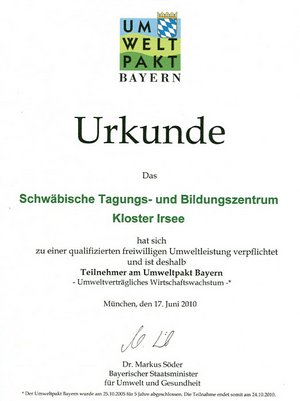
In 2008 and 2012, the Irsee Monastery Swabian Conference and Educational Centre was awarded the Bavarian Environmental Seal for the hotel and restaurant industry by the Bavarian State Ministers for the Environment, Health and Consumer Protection as well as for Business, Infrastructure, Transport and Technology. The gold award honours our climate-friendly operational management – e.g. through the use of big bags packed in an environmentally friendly manner in the hotel industry, the gentle processing of seasonally coordinated and regional food in the restaurant and the energy-efficient use of the refrigeration and heating systems.
In June 2012, the Swabian Educational Centre was granted the certificate concerning participation in the Bavaria Environmental Pact in recognition of its “exemplary commitment to the sustainable development of Bavaria” on behalf of the Bavarian State Minister for the Environment and Health.
The objective of the Irsee Swabian Educational Centre is to assume a pioneering role in sustainable development as a conference centre.
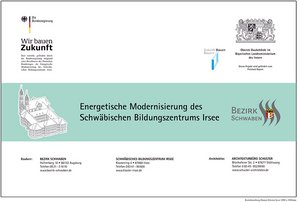
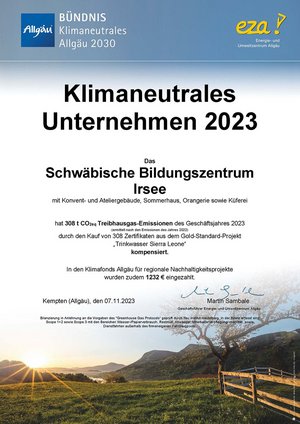
1. Energy saving – heating energy
As part of the support programme “Economic Package II”, the Irsee Swabian Educational Centre received grants in order to achieve energy savings by means of the heat insulation of the listed roof surfaces. In the process, in summer 2010, the roof structure of the artist’s workshop building, including the large artist’s workshop roof window, was renovated to make it energy-efficient. In the course of the winter 2010/11, the uppermost floor roofs of the main building and the theatre followed. Additionally, the centre began to equip large-scale kitchen, refrigeration and heating equipment with technical installations for heat recovery.
2. Energy saving – electricity consumption
Where allowed by monument protection, the Swabian Educational Centre uses energy-saving lights that produce a saving effect of at least 15% compared to common light bulbs. In new investments, modern LED illuminants are increasingly being used. In December 2010, the lift system was converted from an energy-intensive oil cooling to a resource-saving frequency control. Additionally, in September 2015 a block-type thermal power plant was commissioned that can provide the centre with 20 kWh of electricity and 50 kWh of heat energy for fresh water supply.
3. Biogas local heating plant
In the 2nd quarter of 2010, the existing oil heating of the Swabian Educational Centre was converted from the use of fossil fuels to regenerative fuels (biogas) by means of the connection with the Irsee-Oggenried local heating plant. Since then, we have been able to save more than 100,000 litres of heating oil per year, which reduces the CO-2 emissions of the Swabian Educational Centre by 311 tonnes/year.
4. Photovoltaics
The Swabian Educational Centre operates three photovoltaics systems on nearby ancillary buildings of the listed ensemble. Since April 2010, the Educational Centre has used the gym hall roof of the neighbouring Josef Guggenmos primary school for a PV system with an output of 16.5 kWp. In August 2012, a PV system with an output of 34.6kWp was commissioned on our new central warehouse and in September 2014 a system with an output of 18kWp was commissioned on the roof of the buffer storage building of our local heating supplier. Thus, in 2014, we generated 12.5% of the entire electricity consumption of the Irsee Swabian Educational Centre ourselves from solar power.
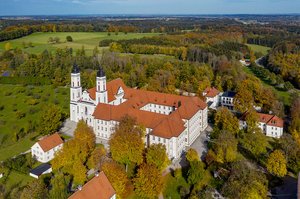
The United Nations have set 22 May as the International Day for Biological Diversity. To emphasise the importance of our environment as a basis of life for human wellbeing, 2010 was declared the International Year of Biodiversity, while 2011 was declared the Year of Forests. The Irsee Swabian Educational Centre is taking up this concept and in 2010 it had a new framework plan created for the entire outdoor facility of Irsee Monastery on the basis of the historical space structure and the current use standards. The result of this is both a forward-looking space concept and a concrete measure plan for the promotion of biological diversity on our site. On this basis, proposals for a new space concept are being developed for the individual habitats and ecological complexes (shrub and tree populations, paths and open spaces, meadows and woods as well as water bodies). The following measures have already been introduced:
1. Natural rejuvenation of the abbey forest
The Irsee Swabian Educational Centre promotes forestry that conforms to nature in the abbey forest (3.6 ha). For instance, the historic “ash break” has already been freed from non-native fig trees. On the entire forest surface, space and light is being successively created for the regrowing young ashes, sycamores, alders und beeches. This leads to a diverse, mixed population from the naturally occurring local tree species. The Educational Centre is supported here by the Kaufbeuren Bureau for Food, Agriculture and Forestry as well as the Kaufbeuren Forestry Community.
2. Meadow with scattered fruit trees
In 1994, the East Allgäu District Association for Gardening and Land Cultivation laid out a meadow with scattered fruit trees, 1.5 ha in size, on the former “gentlemen’s meadow” of Irsee Monastery as an educational fruit garden. Sixty fruit trees were planted and established varieties of apples, pears, plums and cherries for the East Allgäu were selected. The aim is to preserve tried-and-tested fruit varieties, to convey the ecological value of a meadow with scattered fruit trees and to offer practical courses in tree care, fruit-tree pruning und fruit-tree refining. The District Association for Gardening and Land Cultivation is the contact.
3. Beehouse
The approximately thirty year-old beehouse in the abbey forest was reactivated in the summer of 2010 and taken on by the Imker-Schule Schwaben school. Information about the bees in the abbey forest is issued by the State Specialist Advisor on Bee Breeding in the administrative district of Swabia.
4. Patient graveyard
After the Secularisation, in 1849, Swabia’s first stationary psychiatric clinic, the so-called “district asylum”, was set up in the rooms of Irsee Monastery. After the construction of today’s district hospital in Kaufbeuren in 1876, Irsee continued to be used as a “department for the chronically ill” until 1972. During the period of National Socialism, patients were killed at the “Kaufbeuren/Irsee Curative and Nursing Institute” by being placed in central euthanasia institutions, by means of undernutrition or by means of medicine; the so-called “euthanasia graveyard” was set up behind the minster. The complex, which was used as a patient graveyard until the dissolution of the Irsee department, became an important memorial site for the victims of the “euthanasia” in Swabia in 1981 when it was placed under a preservation order. In 2010, the garden of the graveyard was overhauled in accordance with historical plans and photographs. Today, the site emits peace and dignity in its form as a forest graveyard and preserves an honouring memorial for the victims.
5. Abbey pond
The abbey pond, which is designed as a fire protection or sedimentation pond and was equipped with a small turbine for electricity generation during the time of the “Curative and Nursing Institute”, is managed by the Swabian Fish Farm Salgen and is occupied by local fish species. Information is issued by the Specialist Consultancy for Fishery, an institution of the district of Swabia. In addition, a sun deck is available to our guests. In 2015, a picturesque place of retreat from the hectic everyday working life came into being here, one the one hand, and on the other hand another space on the abbey site where peace and creativity meet. In addition to enjoying an enchanting nature experience, one can marvel at the sculpture “Nereus” (a sea god of Greek mythology) of the Irsee artist Peter R. Müller.
6. Bats
Most bats live “under one roof” with man. For instance, in the attic of the church and of the former convent building are summer accommodations of a large species of bat (mouse-eared or serotine bat). The preservation of these existing quarters was taken into consideration in the construction measures for the heat insulation of the top floor roof in the main building.
7. Nature trail
The objective of the spatial planning-based mapping of the outdoor facilities of the Irsee Swabian Educational Centre is to create a nature trail that is to combine the various habitats and sites and illustrate to the visitor their historical and ecological significance.